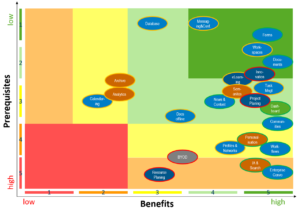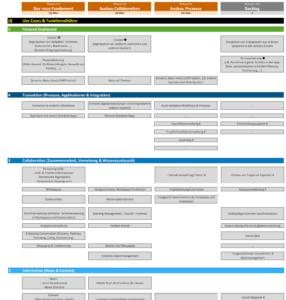Did you stick to your Digital Workplace Roadmap?
Published March 29, 2023 by Stephan Schillerwein
[This article was translated using automated translation software]

When I ask someone from the small intranet and digital workplace world about the progress of their digital workplace, I often hear that they haven’t made nearly as much progress as they once planned. I then ask if they have done what was defined in the roadmap. Unfortunately, the answer to this question is basically always the same: “No, not really…”. But even more interesting is the look that usually goes with it. It’s a “this can’t possibly be the reason why we didn’t reach our goal” look.
Even though the “sat nav” has long since replaced the classic road map, a roadmap is still an appropriate symbol for the enablement of reaching a destination, especially a distant destination with an unclear path. Such a “road map” is also needed for a complex, longer-term project such as a Digital Workplace (DWP) or a Digital Experience Platform (DXP).
What is the purpose of a Digital Workplace Roadmap?
A DWP roadmap can be very simple in design or it can be used as a complex planning tool. Regardless, however, it usually serves the following main purposes:
- To divide the large Digital Workplace project into manageable stages, so that these can then be designed and implemented step by step. In this way, the roadmap also concretizes the digital workplace strategy and makes it more tangible.
- Creating longer-term planning security and ensuring that the ball can be kept continuously rolling (this also includes the regular revision and updating of the roadmap itself, which of course cannot be static in a highly dynamic digital world).
The second aspect in particular is of great importance, as many intranet and DWP development processes consist of high and low phases. High phases are usually dedicated projects in which a big step forward is made. Low phases correspond to “normal operational mode” when little progress is made (and which are usually much longer and more formative of overall progress). It is precisely these that need to be eliminated (or at least reduced) through an appropriate roadmap, because in a DWP roadmap there are usually only phases in which relevant further developments and optimizations take place.
How to create a Digital Workplace Roadmap
The essential steps to create a roadmap are simple and can be done by those with some experience without any particular difficulty.
Required basics
As a basis, analysis results and a digital workplace strategy should be available. If this is not available, one should in any case think in depth about the strategic direction before embarking on the roadmap. The destination on the road map must be at least roughly known (unless it is to be a “journey into the unknown”…).
Prioritization of the use cases
On this basis, the selection of the use cases can then take place (these should be easy to identify on the basis of good analysis results), which can then be prioritized in a workshop. I usually prioritize the use cases by evaluating the two dimensions “benefits “ (“how much benefit does the implementation of the use case bring to employees and the organization”) and “prerequisites” (“how difficult is it to create the prerequisites for a successful implementation of the use case”).
However, there are many other prioritization methods, such as the options outlined in the following Nielsen Norman Group article: «5 Prioritization Methods in UX Roadmapping»
The result of this step could look like this (fictional example):
Elaboration of the actual roadmap
Subsequently, the actual roadmap can be worked out. The first step is to select the form of presentation and the content levels of the roadmap. Since there are no limits to creativity when it comes to the form of presentation, the content levels of the roadmap will be discussed right away. In addition to the usual use cases and functionalities, a roadmap can also show the development steps at other levels, such as the following in particular:
- Required Systems and Modules (Technology Roadmap)
- Change & Adoption (what do you want to achieve on the change and usage level)
- Other solution components (e.g., non-digital solutions, such as new office environments)
- Organization (e.g. roles, governance, …)
- Goals (which goals from the strategy are to be achieved by when and to what extent)
Which levels are selected depends on what is to be achieved with the roadmap and where the problems and development goals lie. If, for example, the organizational level of the digital workplace represents a major problem area, perhaps because the roles are not sufficiently established and are not lived in practice, it makes sense to include such elements in the roadmap.
The time horizon for the roadmap can then be defined and divided into realistic stages. Based on the prioritization already carried out, the concrete elaboration of the contents can then take place in detail.
The result of this step could look like this (excerpt from a fictitious example):
Does the roadmap automatically solve all my Digital Workplace problems?
The roadmap for a Digital Workplace is an important management tool, but of course it is not a magic wand that will make all the plans become reality by itself. Or, to return to the beginning of this post: the best roadmap is of no use if you don’t then use it to consistently follow the best path to your destination.
In this respect, part of the great added value of a roadmap lies in being able to create transparency about the planned journey right from the start, thereby increasing the likelihood of actually being provided with the resources needed for the journey on a permanent basis. And, of course, also to be able to maintain the motivation to reach a goal that may still be a long way off.
The roadmap is therefore part of the planning and control instruments that every manager of a digital workplace should be familiar with, examine, and master.
Picture credits & rights:
- Header picture: „365-211“ by “Canned Muffins” (CC BY 2.0), https://www.flickr.com/photos/cmuffins/5101164988/
- Charts: by Stephan Schillerwein (CC BY-NC-ND)




